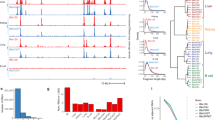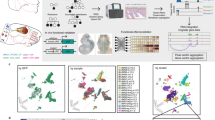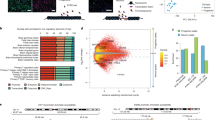Abstract
There is now good evidence that non-coding sequence variants are involved in the heritability of many common complex traits. The current ‘gold standard’ approach for assessing functionality is the in vitro reporter gene assay to assess allelic differences in transcriptional activity, usually followed by electrophoretic mobility shift assays to assess allelic differences in transcription factor binding. Although widely used, these assays have inherent limitations, including the lack of endogenous chromatin context. Here we present a more contemporary approach to assessing functionality of non-coding sequence variation within the Vanin-1 (VNN1) promoter. By combining ‘gold standard’ assays with in vivo assessments of chromatin accessibility, we greatly increase our confidence in the statistically assigned functional relevance. The standard assays revealed the −137 single nucleotide variant to be functional but the −587 variant to have no functional relevance. However, our in vivo tests show an allelic difference in chromatin accessibility surrounding the −587 variant supporting strong functional potential at both sites. Our approach advances the identification of functional variants by providing strong in vivo biological evidence for function.
Similar content being viewed by others
Log in or create a free account to read this content
Gain free access to this article, as well as selected content from this journal and more on nature.com
or
Accession codes
References
Chorley BN, Wang X, Campbell MR, Pittman GS, Noureddine MA, Bell DA : Discovery and verification of functional single nucleotide polymorphisms in regulatory genomic regions: Current and developing technologies. Mutat Res 2008; 659: 147–157.
Knight JC : Allele-specific gene expression uncovered. Trends Genet 2004; 20: 113–116.
The_1000_Genomes_Project_Consortium: A map of human genome variation from population-scale sequencing. Nature 2010; 467: 1061–1073.
Buckland PR : The importance and identification of regulatory polymorphisms and their mechanisms of action. Biochim Biophys Acta 2006; 1762: 17–28.
Cooper GM, Shendure J : Needles in stacks of needles: finding disease-causal variants in a wealth of genomic data. Nat Rev Genet 2011; 12: 628–640.
Goring HHH, Curran JE, Johnson MP et al: Discovery of expression QTLs using large-scale transcriptional profiling in human lymphocytes. Nat Genet 2007; 39: 1208–1216.
Mitchell BD, Kammerer CM, Blangero J et al: Genetic and environmental contributions to cardiovascular risk factors in Mexican Americans—The San Antonio Family Heart Study. Circulation 1996; 94: 2159–2170.
Dupre S, Graziani MT, Rosei MA, Fabi A, Delgross. E : Enzymatic breakdown of pantethine to pantothenic acid and cystamine. Eur J Biochem 1970; 16: 571–578.
Aurrand-Lions M, Galland F, Bazin H, Zakharyev VM, Imhof BA, Naquet P : Vanin-1, a novel GPI-linked perivascular molecule involved in thymus homing. Immunity 1996; 5: 391–405.
Pitari G, Malergue F, Martin F et al: Pantetheinase activity of membrane-bound Vanin-1: lack of free cysteamine in tissues of Vanin-1 deficient mice. FEBS Lett 2000; 483: 149–154.
Bocos C, Herrera E : Pantethine stimulates lipolysis in adipose tissue and inhibits cholesterol and fatty acid synthesis in liver and intestinal mucosa in the normolipidemic rat. Environ Toxicol Pharmacol 1998; 6: 59–66.
Wittwer CT, Gahl WA, Butler JD, Zatz M, Thoene JG : Metabolism of pantethine in cystinosis. J Clin Invest 1985; 76: 1665–1672.
Kaskow BJ, Proffitt JM, Blangero J, Moses EK, Abraham LJ : Diverse biological activities of the vascular non-inflammatory molecules—the Vanin pantetheinases. Biochem Biophys Res Commun 2012; 417: 653–658.
Gorman CM, Moffat LF, Howard BH : Recombinant genomes which express chloramphenicol acetyltransferase in mammalian cells. Mol Cell Biol 1982; 2: 1044–1051.
Gould SJ, Subramani S : Firefly luciferase as a tool in molecular and cell biology. Anal Biochem 1988; 175: 5–13.
Mercola M, Goverman J, Mirell C, Calame K : Immunoglobulin heavy-chain enhancer requires one or more tissue-specific factors. Science 1985; 227: 266–270.
Fried M, Crothers DM : Equilibria and kinetics of lac repressor-operator interactions by polyacrylamide gel electrophoresis. Nucleic Acids Res 1981; 9: 6505–6525.
Garner MM, Revzin A : A gel electrophoresis method for quantifying the binding of proteins to specific DNA regions: application to components of the Escherichia coli lactose operon regulatory system. Nucleic Acids Res 1981; 9: 3047–3060.
Knight JC : Functional implications of genetic variation in non-coding DNA for disease susceptibility and gene regulation. Clin Sci (Lond) 2003; 104: 493–501.
Karimi M, Goldie LC, Cruickshank MN, Moses EK, Abraham LJ : A critical assessment of the factors affecting reporter gene assays for promoter SNP function: a reassessment of −308 TNF polymorphism function using a novel integrated reporter system. Eur J Hum Genet 2009; 17: 1454–1462.
Karimi M, Goldie LC, Ulgiati D, Abraham LJ : Integration site-specific transcriptional reporter gene analysis using Flp recombinase targeted cell lines. Biotechniques 2007; 42: 217–224.
Cruickshank MN, Karimi M, Mason RL et al: Transcriptional effects of a lupus-associated polymorphism in the 5' untranslated region (UTR) of human complement receptor 2 (CR2/CD21). Mol Immunol 2012; 52: 165–173.
Birney E, Lieb JD, Furey TS, Crawford GE, Iyer VR : Allele-specific and heritable chromatin signatures in humans. Hum Mol Genet 2010; 19: R204–R209.
Sherry ST, Ward MH, Kholodov M et al: dbSNP: the NCBI database of genetic variation. Nucleic Acids Res 2001; 29: 308–311.
Almasy L, Blangero J : Multipoint quantitative-trait linkage analysis in general pedigrees. Am J Hum Genet 1998; 62: 1198–1211.
Abecasis GR, Cookson WO, Cardon LR : Pedigree tests of transmission disequilibrium. Eur J Hum Genet 2000; 8: 545–551.
Boerwinkle E, Chakraborty R, Sing CF : The use of measured genotype information in the analysis of quantitative phenotypes in man. I. Models and analytical methods. Ann Hum Genet 1986; 50: 181–194.
Havill LM, Dyer TD, Richardson DK, Mahaney MC, Blangero J : The quantitative trait linkage disequilibrium test: a more powerful alternative to the quantitative transmission disequilibrium test for use in the absence of population stratification. BMC Genet 2005; 6 (Suppl 1): S91.
Wickham H : ggplot: Elegant Graphics for Data Analysis. Springer Inc: New York, 2009.
Franchina M, Woo AJ, Dods J et al: The CD30 gene promoter microsatellite binds transcription factor Yin Yang 1 (YY1) and shows genetic instability in anaplastic large cell lymphoma. J Pathol 2008; 214: 65–74.
Cruickshank M, Fenwick E, Abraham LJ, Ulgiati D : Quantitative differences in chromatin accessibility across regulatory regions can be directly compared in distinct cell-types. Biochem Biophys Res Commun 2008; 367: 349–355.
Rao S, Procko E, Shannon MF : Chromatin remodeling, measured by a novel real-time polymerase chain reaction assay, across the proximal promoter region of the IL-2 gene. J Immunol 2001; 167: 4494–4503.
Rohde C, Zhang Y, Reinhardt R, Jeltsch A : BISMA-fast and accurate bisulfite sequencing data analysis of individual clones from unique and repetitive sequences. BMC Bioinformatics 2010; 11: 230.
Robinson JT, Thorvaldsdottir H, Winckler W et al: Integrative genomics viewer. Nat Biotechnol 2011; 29: 24–26.
Boyle AP, Hong EL, Hariharan M et al: Annotation of functional variation in personal genomes using RegulomeDB. Genome Res 2012; 22: 1790–1797.
Takai D, Jones PA : Comprehensive analysis of CpG islands in human chromosomes 21 and 22. Proc Natl Acad Sci USA 2002; 99: 3740–3745.
Kerkel K, Spadola A, Yuan E et al: Genomic surveys by methylation-sensitive SNP analysis identify sequence-dependent allele-specific DNA methylation. Nat Genet 2008; 40: 904–908.
Kroeger KM, Steer JH, Joyce DA, Abraham LJ : Effects of stimulus and cell type on the expression of the −308 tumour necrosis factor promoter polymorphism. Cytokine 2000; 12: 110–119.
Morley M, Molony CM, Weber TM et al: Genetic analysis of genome-wide variation in human gene expression. Nature 2004; 430: 743–747.
Acknowledgements
This study was supported by the National Institutes of Health Grant HL93537 (to EKM and LJA).
Author information
Authors and Affiliations
Corresponding author
Ethics declarations
Competing interests
The authors declare no conflict of interest.
Rights and permissions
About this article
Cite this article
Kaskow, B., Diepeveen, L., Michael Proffitt, J. et al. Molecular prioritization strategies to identify functional genetic variants in the cardiovascular disease-associated expression QTL Vanin-1. Eur J Hum Genet 22, 688–695 (2014). https://doi.org/10.1038/ejhg.2013.208
Received:
Revised:
Accepted:
Published:
Issue date:
DOI: https://doi.org/10.1038/ejhg.2013.208



